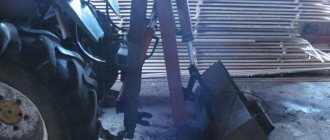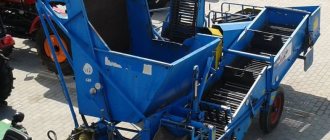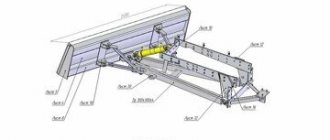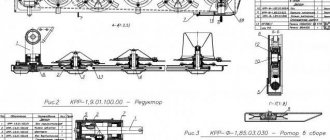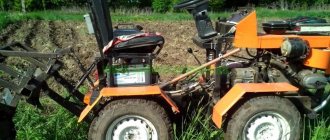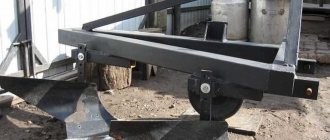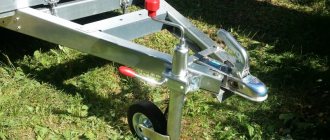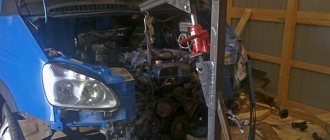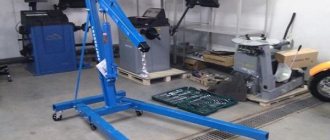Features of a homemade loading mechanism
In many farms, you can often find a tractor (T-40 or MTZ), in which the mounted mechanism is driven by mechanical power take-off, a hydraulic system and suspensions (rear and front).
There is an excellent selection of photos of a homemade loader, which shows working options used in action.
If the proper tools and required materials are available, the cost of hangers can be significantly minimized. If you take into account the characteristics of the equipment, it is possible to make a homemade loader for the rear linkage. This will give you the most suitable volume and the required boom size.
How to make hydraulics
Using a similar mechanism on a mini tractor allows you to get a number of advantages. But the most important thing is that it ensures the stable functioning of additional elements.
Self-assembly of such a structure is very simple; it is important to have a sufficient level of technical knowledge, as well as strictly adhere to the diagram or drawings. To assemble such a device, you need to prepare a number of tools and parts. The sequence of work itself in this case looks like this:
- First, drawings of the future structure are created.
- All required parts are being purchased.
- Their installation is carried out, as well as the installation of the hydraulics themselves.
- After this, the parts are calibrated, and the functionality of the structure along with the transmission is checked.
Homemade minitractor
According to its design, the hydraulics for a minitractor with your own hands consists of the following elements:
- Hydraulic tank where oil is poured.
- Power point.
- Hydraulic pump, as well as distributor.
- Connecting hoses.
- Special hydraulic motors, as well as pistons.
Sometimes, to supplement this, various filters are installed that change pressure indicators and other data. This prevents possible contamination of the pump as well as the power plant from contamination. In the process of drawing up a diagram of the future design, it is important to consider:
- The hydraulic pump must be placed under the tank. This will allow the oil to flow to it by gravity, which reduces problems for the hydraulic system during the starting process.
- For the correct functioning of the mechanism for a long time, it is important to first calculate the power of all combined elements in the unit. It is taking these data into account that the hydraulic pump itself should be selected. When the power of one is not enough, additional installation of an auxiliary element is required. The latter will begin to work when the maximum load in the system is reached.
- To ensure long-term and trouble-free operation of the unit, sensors must be installed to measure the pressure level in the system, as well as filters designed to clean the oil.
Be sure to read: Buy an MTZ cabin
In order for the fluid to fulfill its role in the system, it is important that it is constantly in motion. A similar function is performed by a hydraulic pump that transports oil throughout the entire system. The power unit connected to it transmits torque, thereby activating the fluid exchange mechanism. The pump itself is connected to the distributor. Based on the position in which the lever is located, the oil returns to the tank or it goes in a different direction to the hydraulic motor or pistons.
As a result, due to the high density of such a liquid, it allows for heavy traction movements. In the form of an engine for such a unit, different options are used, from electric to diesel.
An important condition is the need to provide sufficient power for the operation of the hydraulic pump for the mini tractor.
Selection and procurement of parts
The need for such a system is due to the simplification of the functioning of the pistons, as well as easier movement of the unit. To avoid problems during soil cultivation, a hydraulic system is used, since the minitractor itself has insignificant traction properties. As a result, you need to purchase the necessary elements, modify the design, and then assemble the device. You can buy structural elements separately or as a set. It is important that each group of pistons has its own lever. For small units, 3 levers are sufficient:
- For braking.
- For frame control.
- To start hydraulic motors.
Hydraulic motor installation diagram
Advanced models use distributors equipped with additional functionality. However, the price of such options is significantly higher than classic products. The selection of the purchased hydraulic pump is carried out based on the following parameters:
- The level of pressure required to start the power plant. If this is insufficient, the hydraulic motor simply will not start working.
- Pumping speed measured in l/min. Determines at what speed the pistons and motors will operate.
Basic technique and tools
Practice has shown that the best basis for a homemade loader on the rear tractor linkage is MTZ equipment (Belarus). The tractor can be found almost anywhere in Russia.
When starting work, it is worth having a complete understanding of both the positive and negative aspects of such activity. Clear benefits include:
- For each specific case, you can accurately select the appropriate dimensions, that is, height and length;
- Economic expediency. A simple preliminary assessment of the cost of the forklifts being sold will show a noticeable difference in cost.
What should be considered significant disadvantages:
- Relatively low power when compared with equipment produced in factories;
- The need for metal (in large quantities) and special tools.
For many, according to experts, the third option is beneficial. Do not create a loader yourself, but purchase a cheaper model that has already worked for some time.
As for tools, many will consider the cost of a new high-quality tool to be quite high. Then you can think about buying a used instrument.
It is very important to have experience working with metal structures. In its absence, the quality of the device that needs to be manufactured will be unimportant.
During the work process, it is necessary to join the metal elements well. If they are not adjusted to each other, the strength of the loader will be insufficient.
It is important to make the correct calculation of both balance and length. Otherwise, there is a high probability that the equipment may tip over.
Mini tractor hydraulics - design and principle of operation
The hydraulics of a modern mini tractor is a whole complex of elements and mechanisms that transform the energy of the unit’s engine and transmit it to the executive units. This principle of operation provides the farmer with the opportunity to control trailed, mounted and semi-mounted implements, as well as adjust the operation of the devices used by changing the rut depth, raising the frame and other settings.
Oil circulates inside the hydraulic system of a minitractor - the main working fluid, the function of which is to convert energy and transmit it to the actuators.
Other elements that are required for stable operation of the minitractor’s hydraulics include:
- a pump with a drive and a switching mechanism - this unit is necessary to create and maintain the optimal pressure inside the system for its operation;
- reservoir for filling oil - this container must be of such dimensions that it can hold a sufficient amount of working fluid;
- filter element - required for continuous oil purification and protection against damage to friction hydraulic mechanisms;
- pipeline system - oil circulates through tubes from the reservoir to the executive units and back;
- hydraulic distributor - plays the role of an element directing oil to the final working link. The second function of the distributor is to switch the entire hydraulic system to idle mode. If the load on the system is exceeded, the distributor reduces the operating pressure in the pipeline;
- hydraulic cylinder - this element receives oil from the distributor. It is necessary for raising and lowering the attachments used;
- hydraulic motor - this mechanism is connected to the wheels of the mini tractor;
- valves, shut-off couplings, bends, hoses and coolers are consumable items that most often need replacement.
The hydraulic design of a mini tractor is quite complex. In this regard, before assembling a homemade hydraulic system, it is extremely important to study the diagrams in detail and take into account all the subtleties of manufacturing the device.
Manufacturing stages
Having chosen MTZ, T-40 or T-25 as equipment, you can begin designing.
- Stage 1. Find drawings (or do them yourself), in which you indicate the appropriate proportions of metal parts and dimensions.
- Stage 2. To make a homemade loader for a tractor, you will need to select the following materials and equipment:
- Steel sheets;
- Profiles (metal);
- Hinged joints;
- Cylindrical elements left over from old hydraulic equipment;
- Corner grinder or cutter;
- Bolts and washers, pliers and hammer;
- Apparatus for welding work.
The base of the bucket is made of profiles and sheets. The selection of metal is carried out taking into account the thickness corresponding to the dimension of the structure being created.
Three joints on hinges, the shape of which is cylindrical. Two will allow the bucket to tilt, the third larger size will allow the boom to rise.
A grinder can be used to cut metal profiles. When choosing a welding machine, you must give preference to the most powerful equipment.
The main indicators regarding reliability, as well as strength and durability depend on the proper operation of the welding unit. All small tools, including pliers, must be available.
Build process
When making a homemade mini tractor loader, you need to follow certain rules.
- At the first stage, a base is made in the form of a rectangle with pipes having a square cross-section. You can use metal corners for these purposes. The lower edge of the frame is intended for mounting on a canopy, so it protrudes slightly. A second rectangle (made of pipes) is strengthened in the central part. The hydraulic cylinder is installed directly on it. The upper part is intended for the manufacture of spacers, as well as hinges for the boom.
- The arrow itself is performed at the next stage. You will need metal profiles connected at a 30 degree angle. The hydraulic cylinder and the ends of the base are fixed to the structure in the upper part. The hinge (cylindrical in shape) complements the central part of the boom. This place is intended for fixing movable connecting sections. They are attached by means of cylinders, as well as crossbars for mounting the bucket.
- The next stage is making the bucket. To do this, it is enough to use four steel sheets. You can replace them with one of sufficient size. The cut metal rectangles are welded together. The front one is located at an angle.
When manufacturing a loader based on MTZ, do not forget that the length of the boom should not be more than two meters.
Such a requirement must ensure the stability of the equipment during operation, without giving any possibility of it unexpectedly overturning.
How to install
When all the components have been purchased, all that remains is to assemble the minitractor, in the process connecting all the elements. To do this, the engine must be connected to a purchased hydraulic pump. Further from it, the tubes are connected to the distributor, after which directly to equipment in the form of pistons, motors, as well as a hydraulic tank connected to the pump. In this case, it is necessary to install filters between the tank and the pump, which are necessary to clean the oil.
Be sure to read: OSAGO insurance for a tractor
Upon completion of installation, all systems must be checked. If problems are identified in operation, all hoses are examined for integrity, as well as tightness of connections. When everything is good, the unit is tested during a test drive. At this time, correction is made to the functioning of the steering hydraulics, as well as movement, if there are deviations. The floating steering system should be eliminated.
